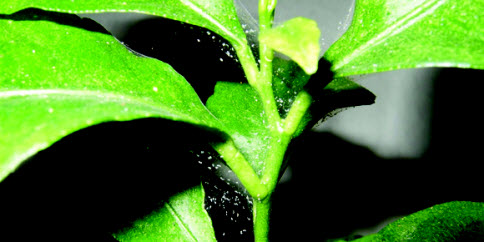If you see spider webs on your houseplants, it’s probably already too late to deal with the pesky two-spotted spider mite, Tetranychus urticae, the scourge of house plant lovers everywhere. The webs are there to deter predators and protect eggs laid on the underside of leaves and when that happens, the infestation will be far along.
If you detect spider mites on a plant, quarantine it immediately. The tiny eggs and animals can float on air currents or be carried on your clothes or shoes or even by your pets. Mites on one plant can threaten your entire indoor garden.
Where did they come from? Chances are you recently bought a new plant or a friend gave you some cuttings. Infested plants often come from big-box stores that don’t have the time or the expertise to care properly for their plants. But no matter where you obtain them, new additions to your indoor greenhouse should be quarantined for the first couple of weeks.
These pesky animals are not insects nor are they exactly spiders. Even though the nymphs have six legs, the adults have eight. They are closely related to actual spiders and to ticks and scorpions. Don’t bother to try and count the legs unless you have a really good magnifying glass. Spider mites are the size of a pin-head — 1/50th of an inch long.
Spider mites produce about eight generations a year. It takes just three days to hatch the 20 eggs a female will lay in a 24-hour period and only five days until the hatchlings become sexually mature. The adult mother goes on laying eggs for her whole life — anywhere from two to four weeks. But these wily animals can also go dormant when threatened so there is no safe rule of thumb for control, except to keep it up and be vigilant.
Suck is what they do. They insert their miniscule mouth parts into your plant and suck it dry. One of the first symptoms of an infestation is stippled leaves. The infested plant may look like it has had a thousand little pinpricks, which it has, or it might even look “dusty.” Eventually, the leaves turn yellow and drop. Turn the leaf over and you may see the buildup of mites and their eggs on the underside.
Because they reproduce so quickly, they also just as quickly develop resistance to insecticides. And anyhow, pyrethrums kill adults but not the eggs.
The best line of defence is to clean the plant with water. You can also use an insecticidal soap. A house plant can get a good wipe down plus a bath every two to four days for a couple of weeks and then hope for the best. Continue to keep conditions humid by spritzing the plant frequently, spider mites prefer hot dry environments indoors.
The outdoor cousin
The spruce spider mite, Oligonichus ununguis, is one of the more than 1,200 spider mite species around the world. It enjoys sucking the life out of cedar, juniper, fir and larch.
If you look closely at an infested tree, you will see stippled needles flecked with yellow. Severe infections will display webbing. Often the homeowner won’t notice anything until the inner branches of his tree become bare of needles. The infestation starts at the branches closest to the trunk.
Spider mites can kill a tree and are especially active in cool springs and falls. One way to check evergreen trees for mites is to hold a sheet of white paper under a branch. Shake the branch, then run your hand over the paper. Spider mites will show up as coloured streaks that are usually red, but they could be yellow, orange, brown or grey!
To protect your evergreens, give your trees a thorough wash with a sharp spray from the garden hose a few times a year, starting in springtime. This can also help get rid of other insects and their eggs. Natural predators include ladybugs, which will eat spider mites if aphids are not available. They eat nine mites an hour.
You can also spray trees with 20 per cent neem oil or cottonseed oil.



